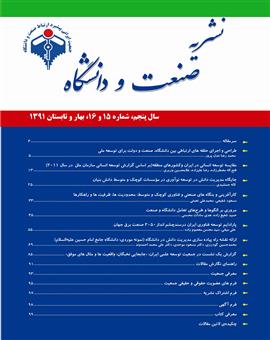مروري بر الگوها و طرحهاي تعامل دانشگاه و صنعت
محورهای موضوعی :
1 - دانشگاه آزاد گرمسار
2 -
کلید واژه: دانشگاه, صنعت, توسعه ملي, انتقال دانش, فناوری پیشرفته,
چکیده مقاله :
دانشگاه و صنعت دو نهاد کلیدی هر جامعهای محسوب میشوند و از آنجاییکه توسعه همه جانبه جوامع و کشورها تا حد زیادی ناشی از کاربست توانمندیهای هر کدام از این دو نهاد در جهت رفع نیازهای همدیگر میباشد، نظر سیاستگذاران، برنامهریزان و مجریان آنها را به خود جلب کرده است و مقوله ارتباط مستمر و بهینه دانشگاه و صنعت را مورد توجه قرار داده است. اين مقاله در راستاي تبيين رابطه دانشگاه و صنعت، نخست به پيشینه موضوع در دنيا و ايران پرداخته و سپس اين موضوع را به عنوان چالشي فراروي جامعه در ارتباط با آموزش عالي، مورد بررسي قرار داده است و در ادامه ضمن معرفي ساز و كارهاي تعامل دانشگاه و صنعت با اقتباس از روشهاي انتقال دانش و فناوري، الگوهاي تعامل دانشگاه و صنعت را نيز با نشأت از الگوهاي نوآوري و رشد فناوري، تشريح كرده است. آنگاه با مروري بر طرحهاي به كار گرفته شده جهت تعامل دانشگاه و صنعت، منافع متقابل اين دو نهاد از برقراري رابطه را با توجه به دادهها و ستاندههايي كه با همديگر دارند، توضيح داده است.
University and industry are two key institutions in any society and since the comprehensive development of communities and countries, largely due to Capabilities of the application of either of these two institutions in order to meet needs is, The policy makers, planners and executors of them has attracted And the concept of continuous improvement of university-industry relationship is considered. This paper aimed at explaining the relationship between universities and industry, the first world record in Iran And then this challenge as a society with higher education, has studied and the introduction of the mechanisms of interaction with universities and industry adoption of methods to transfer knowledge and technology, Emanating from university-industry interaction patterns with patterns of innovation and technology development, has been described. Used when reviewing proposals for university-industry interaction, Mutual benefits of establishing a relationship with these two institutions that together have given the data and outputs, is described
1. آييننامه تاسيس پاركهاي علمي و فناوري. معاونت فناوري وزارت علوم، تحقيقات و فناوري. شوراي گسترش آموزش عالي، 1381.
2. انتظاری، یعقوب، تعامل علم و صنعت در چارچوب نظام ملی توسعه دانش، نشریه مجلس و پژوهش، نشر مرکز پژوهشهای مجلس شورای اسلامی، سال دهم، شماره چهل و یکم، ویژه نامه آموزش عالی، 1382.
3. خسرويان، غلامرضا، بررسي انتزاع متقابل از ارتباط سه جانبه صنعت، دولت و دانشگاه، سومين كنگره بينالمللي همكاري دولت، دانشگاه و صنعت براي توسعه ملي، دانشگاه تبريز، 1385.
4. رشمه، جواد، بدرقه، علي، مير اسماعيلي، مجيد، تعامل دانشگاه و صنعت: ضرورتي اجتنابناپذير، همایش آموزش عالی در هزاره سوم، باشگاه پژوهشگران جوان- دانشگاه آزاد اسلامی واحد رودهن، 1386.
5. شجاعی، محمد رضا، تعامل دانشگاه و صنعت و نقش آن در توسعه اقتصادی، نشریه مجلس و پژوهش، نشر مرکز پژوهشهای مجلس شورای اسلامی، سال دهم، شماره 41، ویژه نامه آموزش عالی، 1382.
6. شفیعی، مسعود، ارتباط صنعت و دانشگاه آیندهای تابناک، پیشینهای تاریک، مجله نامه فرهنگ، شماره 52، 1383.
7. صدقی بوكاني، ناصر، نقش دانشگاه و پژوهش در ارتقاء سطح صنعت در فرايند توسعه ملي، همایش آموزش عالی در هزاره سوم، باشگاه پژوهشگران جوان- دانشگاه آزاد اسلامی واحد رودهن، 1386.
8. هاشمی داران، حسن، قائد محمدی، محمد جواد، اهمیت ارتباط صنعت و دانشگاه برای توسعه آموزش عالی در هزاره سوم، همایش آموزش عالی در هزاره سوم، باشگاه پژوهشگران جوان- دانشگاه آزاد اسلامی واحد رودهن، 1386.
9. هریش، ورنر ، وبر، لوک ای، چالشهای فراروی آموزش عالی در هزاره سوم، مترجم: گروه مترجمین، تهران، دانشگاه امام حسین (ع). چاپ اول 1381.
10. Denison, E.F; Why Growth Rates Differs; Washingtin D.C: The Brookings Institution 2005.
11. Goktepe, D & Edquist, C. Understanding of University-Industry Relations: A Comparative Study of Organizational and Institutional Practices of Lund University, Sweden, Draft Work for PhD Proposal, 2004
12. Park,J.S, Opportunity Recognition and Product Innovation in Entrepreneurial high-tech Start-ups: a New Perspective and Supporting Case Study, Journal of Technovation,26 ,Pp 739-752,2005.
